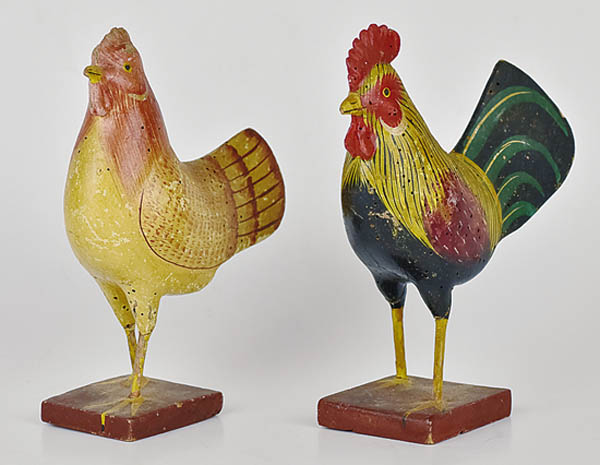Soap Hollow Small-Size Cupboard Sells at Forsythes'
So what is Soap Hollow furniture? As referenced by Antiques and Auction News editor, p4A contributing editor, and Maine Antique Digest freelance writer Karl Pass, Soap Hollow furniture was produced roughly from 1830 to 1890 in Somerset County, Pa. The name was reportedly coined from the brown soft soap produced throughout the region, which lies in a hollow. This Western Pennsylvania enclave of Mennonite cabinetmakers worked predominately north of Davidsville in Conemaugh Township.
Eight cabinetmakers are associated with the Soap Hollow School of cottage craftsmen. Among the known makers are John Sala, Christian Blauch, Peter Thomas and Jeremiah Stahl. All produced furniture with similar design, construction and decoration. The majority was paint-decorated and incorporated cut-paper stencil decoration. Dark red or maroon with black moldings and feet were a popular color combination. Some later pieces were grain-decorated and had floral decals as embellishment. The stencil decoration was often done in gilt and included floral and geometric design work. Many Soap Hollow chests possess the initials of the individual it was made for on the front left and the date to the right. This information is often placed on the sides of chest of drawers.
The primary form was the chest and chest of drawers, although sewing boxes, cradles, rope beds, Dutch cupboards, hanging cupboards and a tall-case clock are known to exist. The unique body of work that is Soap Hollow expresses a material culture rooted in both Germanic and Neoclassical traditions.
The example sold by Forsythes was a youth size (60-inches high) corner cupboard attributed to John Sala. Having the signature dark red grain-painted ground with various floral and star/geometric stencils on the frame of the cupboard, the black cove molding top also had stenciled floral returns over a single black door, again with stencils on the frame and four panes of glass.
Other attributes of this piece included a brass lock and two shelves over a cutout pie shelf, over a single overlapping dovetailed drawer in black paint with a brass pull. A single panel door with a black panel having floral stencils and a brass lock completed the body of the cupboard, which sat on scroll cutout feet.
Twenty-five stencils total made up the decorative work on the piece, which again was attributed to John Sala based on the same paint scheme and color used by him on a signed stepback cupboard with stenciled urns and tulips that match a blanket chest by him dated 1851 as referenced by Soap Hollow expert Charles R. Muller in his book, Soap Hollow: The Furniture and its Makers (Canal Press, 2002) pages 19 and 27.
When contacted about this Soap Hollow cupboard, Muller replied, I went to look at the cupboard, and it's very nice at five feet tall and 23 inches on the sides. In this day when houses do not have corners made for traditionally large corner cupboards, this one would fit anywhere. Condition is excellent. The door is square pinned, and the drawer is dovetailed with wedges. The surface is fine but dark, and the stenciled decoration is okay but, again, not bright. There is no date or initials or any identifying marks, and it came from a local house whose family had moved from Pennsylvania.
Muller then predicted, I would look for it to bring $20,000 to $25,000 and expect the same person who bought the small Soap Hollow chest of drawers at Garth's Auctions last fall to possibly purchase this cupboard, as well.
Muller knows his Soap Hollow and what a buyer might spend. This youth-size Soap Hollow cupboard sold to a dealer in Pennsylvania (and it was the same buyer from Garths) for $22,000 (est. $8,000-$15,000). Prices reported are hammer prices and do not include the buyers premium.
Though the Soap Hollow piece was definitely the star of this Forsythes Auctions event, other furniture that found new owners included a circa 1830 Philadelphia mahogany bookcase in three sections with four glass doors (12 panes each). The consignors family stated that the piece descended in the family of Ann Rudolph Smith, daughter of Rev. William Smith, D.D., first Provost of Academy of Philadelphia, which in 1779 became the University of Penn. The bookcase made $1,600 (est. $1,000-$3,000). And a circa 1770 Philadelphia or New York Chippendale chair with the same estimate as the bookcase sold for $1,400.
Smaller decorative items that sold included a circa 1850 scrimshaw tea caddy made to look like a two-story, center chimney, New England home sold for $1,500 (est.$500-$800); a folk art carved rooster and hen in original polychrome painted finish, 6.75 inches tall, $750 (est. $100-$200); and an early egg basket with a rectangular top and buttocks form in old white paint, which realized $550 (est. $60-$120).
For further information, call Forsythes at 937-377-3700 or visit www.forsythesauctions.com.










